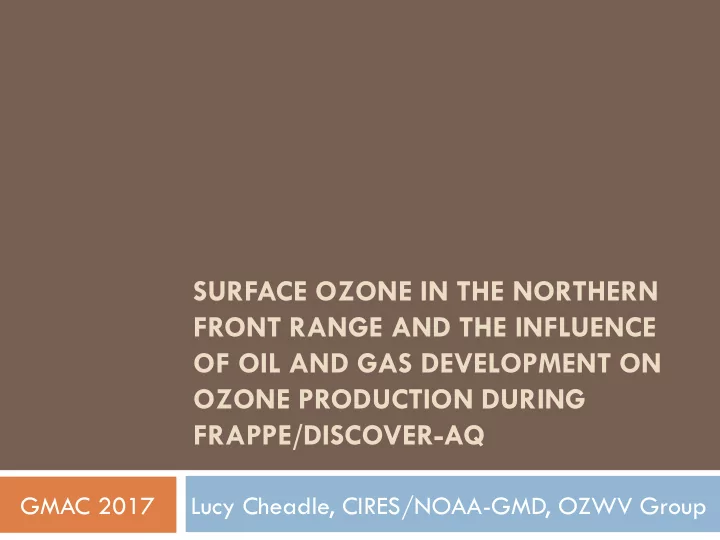

SURFACE OZONE IN THE NORTHERN FRONT RANGE AND THE INFLUENCE OF OIL AND GAS DEVELOPMENT ON OZONE PRODUCTION DURING FRAPPE/DISCOVER-AQ GMAC 2017 Lucy Cheadle, CIRES/NOAA-GMD, OZWV Group
Contributors Samuel Oltmans, NOAA GMD Gabrielle Petron, CIRES/NOAA GMD Russell Schnell, NOAA GMD Erick Mattson, CDPHE Scott Herndon, Aerodyne Research Inc. Anne Thompson, NASA/Goddard Space Flight Center Donald Blake, University of California, Irvine Audra McClure-Begley, CIRES/NOAA GMD Daniel Wolfe, NOAA PSD Eric Williams, NOAA CSD Hannah Halliday, Pennsylvania State University Cody Floerchinger, Aerodyne Research Inc.
Overview Surface ozone (O 3 ) in Front Range Motivations “Background” O 3 from surface sites Summer 2014 O 3 summary Spatial variability at surface sites Case studies Three days Mobile lab drives Surface monitoring stations Discrete air samples in flasks
Motivations Surface ozone (O 3 ) in Front Range Nonattainment area since 2007 EPA NAAQS: During summer 2014: 75 ppb for 4 th highest 8-hr average daily max averaged over 3 years 2015-present: 70 ppb O 3 precursors: VOCs + NOx + sunlight = O 3 Statewide NOx reductions but still exceeding O 3 standard VOC sources play a role Oil and gas activities major source of VOCs in the Front Range
“Background” O 3 Estimated underlying O 3 distribution on days without significant photochemical production to be 45-50 ppb Used long-term data from Niwot Ridge on days without significant upslope events Days w/ peak O 3 <60 ppb Days w/ peak O 3 >75 ppb (Jun-Aug 2013-2015) (Jun-Aug 2013-2015) ~35% of days in Front Range, 56% of days at Niwot Ridge ~15% of days in Front Range, 10% of days at Niwot Ridge
Summer 2014 and Spatial Variability July 16 – August 16, 2014: FRAPPE and DISCOVER-AQ field campaigns Cool and damp during July and August, 2014 2014 was low O 3 summer overall Some days O 3 high at multiple sites, other days more localized Influence of local and regional precursor sources High O 3 observed throughout Front Range and not confined to Denver area
Case Studies Dates: July 23, August 3, August 13, 2014 Weather summary July 23: max temp 32°C, clear sky after AM August 3: max temp 31°C, clear sky August 13: max temp 33°C, clear sky Types of data included Mobile laboratory gas measurements (Aerodyne) Mobile laboratory wind data (Aerodyne) Discrete air samples in flasks (UC Irvine) Surface monitoring sites (CDPHE, NOAA, and NASA)
July 23: O&G emissions, moderate O 3 levels Drive start: 10:00 (LST) Drive end: 16:10 Surface O 3 at monitoring sites: BAO: >75 ppb Platteville: >75 ppb Greeley, Fort Collins, Niwot Ridge all moderate
July 23: O&G emissions, moderate O 3 levels Wind rose from mobile lab during Gases measured on mobile lab: 14:00-16:10 O 3 Methane (oil and gas, agriculture, landfills, wastewater treatment plants) Ethane (oil and gas) Carbon Monoxide (urban) Ammonia (agriculture) Nitrous Oxide (agriculture and wastewater treatment plants) Low emission levels overall during drive Increased concentrations at 4:00 PM coincided with regional shift in surface winds
August 3: Mixed emissions, high O 3 day Drive start: 10:15 Drive end: 18:00 (interrupted at 12:45) High O 3 at monitoring sites: Greeley: >80 ppb FTC (both sites): >80 ppb
August 3: Mixed emissions, high O 3 day Wind rose from mobile lab during 11:15-13:00 Increasing O 3 production, ethane, and methane during drive Oil and gas influence Decreasing CO with increasing O 3 Urban emissions not dominating O 3 formation Higher ammonia and nitrous oxide Agricultural emissions present Less potential for O 3 production from these sources
August 13: O&G emissions and localized elevated O 3 Drive start: 7:20 Drive end: 14:20 High O 3 at monitoring sites: FTC-CSU: peak of ~90 ppb Greeley and Platteville: peak of ~70 ppb
August 13: O&G emissions and localized elevated O 3 High O 3 in remote area Linked to elevated ethane and Wind rose from methane mobile lab during Likely oil and gas precursor source 13:00-14:00 Lower, background levels of agricultural and urban emissions Slightly elevated CO correlated with ethane but not acetylene O 3 levels at ~30 ppb above background
Conclusions “Background” O 3 in Front Range ~40-45 ppb Mobile lab drives measuring O 3 at 30-35 ppb above “background” Influence from four main sectors on local emissions as seen in methane levels Oil and gas, urban, agriculture, wastewater treatment plants Large influence of oil and gas emissions on O 3 formation Some influence of urban emissions on O 3 All case studies show potential influence of oil and gas Aug 13 shows most unambiguous evidence of oil and gas as source of O 3 precursors with enhancement up to 30 ppb of O 3
Additional Slides Surface Sites NE of Greeley Isoprene in Flasks MesoWest Winds August 13 References
Additional NE Sites All days June, July, August 2013-2015
Additional NE Sites Days w/ peak O 3 >75 ppb Days w/ peak O 3 <60 ppb
Additional NE Sites – 1 Week
Isoprene in Platteville Isoprene is the most prevalent naturally occurring biogenic VOC in the northern Front Range and the average mixing ratio measured at the BAO Tower during the summer of 2015 was 0.2 ppb (Abeleira et al., 2017) Measurements of isoprene in Platteville July 23 average: 0.04 ppb August 3 average: 0.03 ppb August 13 average: 0.06 ppb All case study values less than the 0.2 ppb average measured at BAO Tower during summer 2014. Biogenic VOCs likely did not contribute as much to O 3 production during case studies than during summer 2015
August 13, 2014 MesoWest Surface Winds 10:00 AM, 11:00 AM, 12:00 PM, 1:00 PM
10:00 AM
11:00 AM
12:00 PM
1:00 PM
Recommend
More recommend